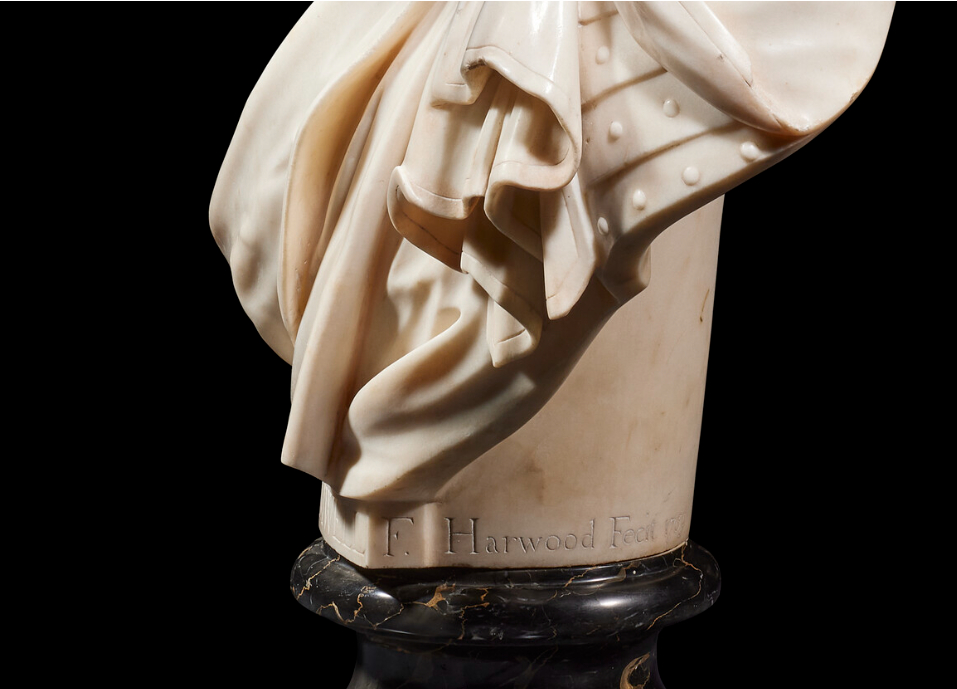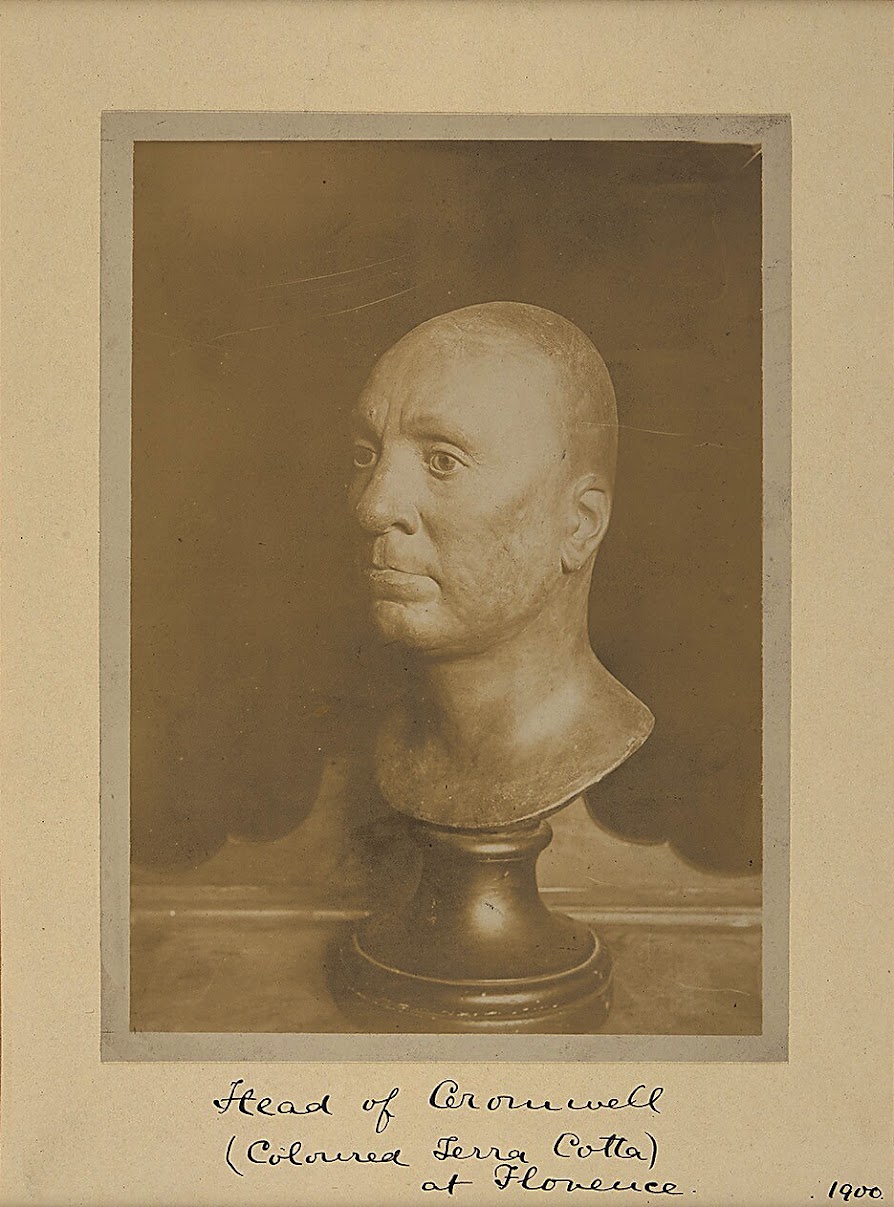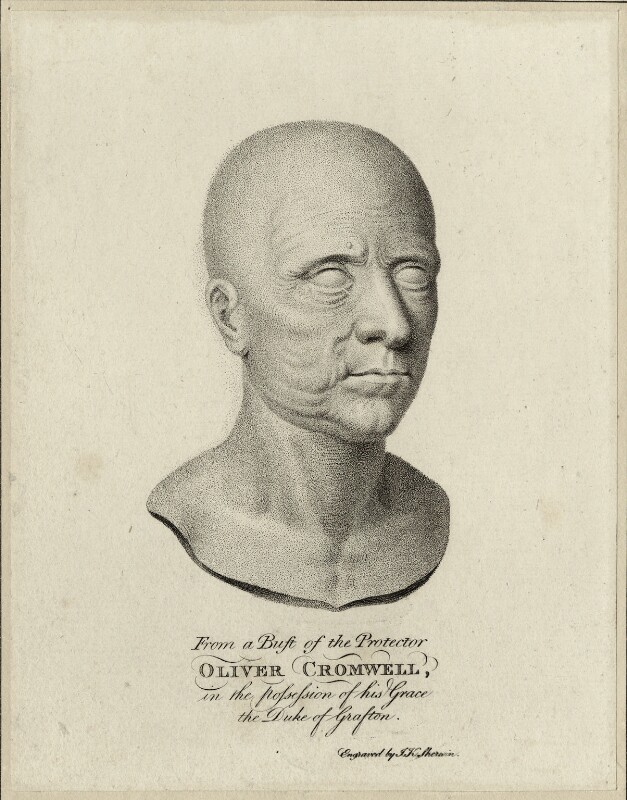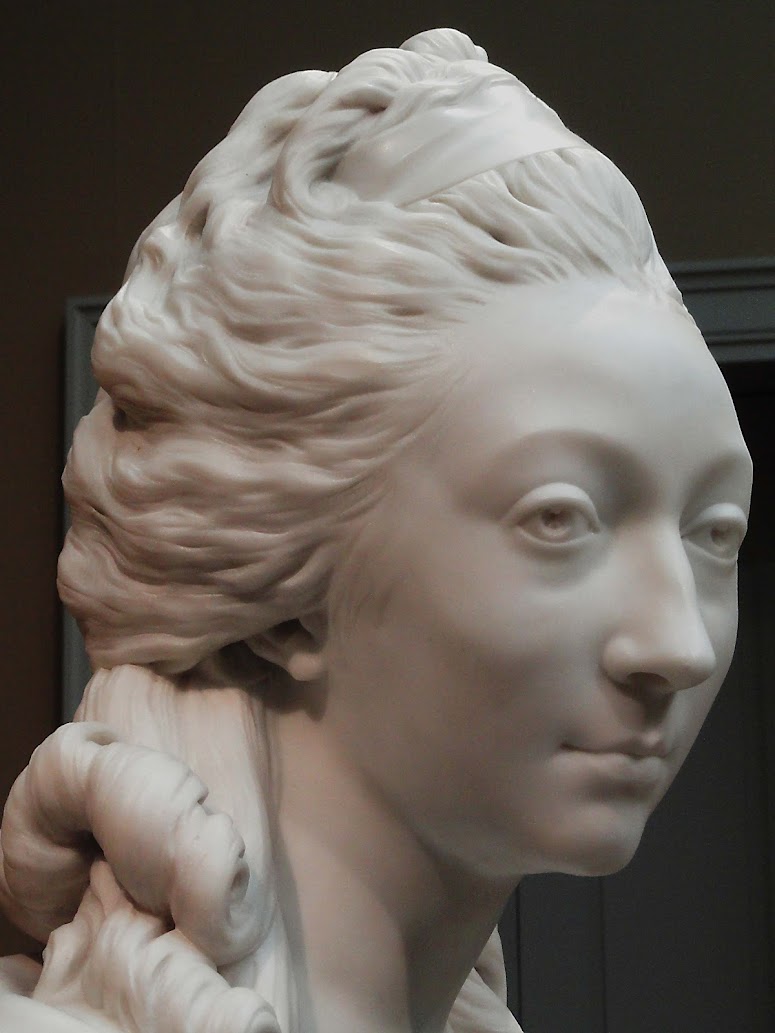This post prompted by a recent conversation with Johnny Tomasso.
When I started this blog I had no idea of where it would lead and have discovered on reviewing some previous post, that the information available at the time was either misinformed or just missing - this post is a case in point.
......................
The Marble Bust of Oliver Cromwell by Francis Harwood.
Inscribed F Harwood Fecit 1759.
It uses the typical coloured marble oval section socle much employed by Harwood.
Sold for 75,600 Euros.
Sold for £272,750
51.4 cms.
...............
I don't usually publish the prices made at auction - which I believe are irrelevant to the artistic and historical value of these objects - but in this case I will make an exception.
Why the big price difference? - presumably there were only two potential buyers who wished to buy the Christie's London Harwood version of the Cromwell bust which came up for sale in 2018.
Did the underbidder buy the recent Christies Paris bust? If so they appear to have payed a bargain price.
or was it the buyer of the 2018 bust who purchased this bust??
Maybe they smashed it up to make theirs rarer? (joke!)
If anyone understand the vagaries of the price and cost of works of art - particularly of portrait sculpture perhaps they would let me know.
I have written a great deal on the sculptural Iconography of Oliver Cromwell. There is an in depth study of the Harwood busts at -
This is probably not the last post on the subject!
The Christie's Paris Catalogue Entry -
My thoughts -
The so called anonymous sale is not anonymous - this is the bust from Wentworth Woodhouse sold 15 July 1986. See the Paul Mellon Photographic Archive photograph below.
A comparison with the veining on the socle in the Mellon Photograph and the Christie's Paris Catalogue Photograph reveals that they are one and the same bust.
Provenance -
They say -
Sir Wyndham Knatchbull-Wyndham, 6th Baronet (1737-1763),
Mersham-le-Hatch, Kent;
then by descent to Lord Brabourne.
Anonymous sale, Christie's, London, 15 July 1986, lot 73.
It is not anonymous - this the bust described as from Wentworth Woodhouse sold 15 July 1986 on the photograph from the Paul Mellon Archive below? It is visible in a photograph of the Knatchbull house at Mersham le Hatch (see below). I can find no other reference to a bust of Cromwell at Wentworth Woodhouse.
Cyril Humphris, London Dealer - His sale, Sotheby's, New York, 10 January 1995, lot 66.
Important French private collection.
.............................
There is no doubt in my mind that the so called Wentworth Woodhouse Bust from the Paul Mellon Photographic Archive (illustrated below) is the same as that sold by Christie's Paris - Lot 17, November 2024.
The photographs of the 1759 Wentworth Woodhouse Harwood
bust of Cromwell in the Paul Mellon Archives.
-------------------
The Very poor quality Images below from artnet.com
Oliver Cromwell
Signed and dated F. Harwood fecit 1759.
and sold again from the Cyril Humphries Collection, Sotheby’s, New York, 10 January 1995, lot 66.9
Another Harwood Bust
of Oliver Cromwell.
51.4 cms.
Information below lifted entirely from Christie's catalogue entry.
Provenance -
Literature.
COMPARATIVE LITERATURE:
A. Dawson, Portrait Sculpture, A catalogue of the British
Museum Collection c.1675-1975, 1999, p. 77.
Christie's Lot Essay.
This exceptional marble bust was carved by Francis Harwood, a leading British sculptor who spent the majority of his career working in Florence. Depicting Oliver Cromwell, a principal military and political figure of the preceding century, the provenance of the bust is particularly illustrious having come from the historic collections of the Earls of Granard at Castle Forbes, Ireland.
The present bust is the earliest of four known portraits of
Cromwell in marble that are signed or attributable to Harwood. Dated 1757, the
present bust is one of the sculptor’s earliest known works in marble and is
likely to be the prime version of Harwood's busts of this subject.
The three other known versions are:
One signed and dated F. Harwood fecit 1759 previously in the
collection of Lord Brabourne, sold at Christie’s, London, 15 July 1986, lot 73
and again from the Cyril Humphries Collection, Sotheby’s, New York, 10 January
1995, lot 66;
Of the four versions? the present bust is seemingly the liveliest and finest in the details. Harwood’s portrait of Cromwell shows the great historical figure full of vigour and in thoughtful and controlled contemplation. The Lord Protector is shown looking slightly to his left, with thick curls of hair magisterially drilled and undercut in places. A wart is clearly defined over his thick right eyebrow, a reference to Cromwell’s alleged instruction to either Peter Lely or Samuel Cooper; ‘I desire you would use all your skill to paint my picture truly like me, and not flatter me at all; but remark all these roughnesses, pimples, warts and everything as you see me.’
Cromwell was intensely religious and a puritan, opposed to all forms of personal vanity, and versed in this history Harwood followed a tradition of depicting Cromwell as a serious man, not inclined to cover up signs of approaching old age, as can be seen in the slightly sagging skin and receding hair of Harwood's bust.
The emergence of this bust and its dating of 1757 sheds an important light on Harwood’s life, and suggests that these early years in Florence were the most enterprising and energetic of his career. Harwood spent most of his life in Italy, arriving in Rome in 1752 before settling in Florence the year after, where he worked in the studio of Giovanni Battista Piamontini, and then took charge of this studio after the latter’s death in 1762.
The
sculptor won the attention and admiration of the visiting British Grand
Tourists after he was awarded the public commission for a statue of Equity to
surmount the new Porta San Gallo in Florence. Most prominent amongst his
patrons were Robert and James Adam, who commissioned Harwood to create a
lifesize Apollo for the dining room at Syon House, and he won the praise of the
British envoy Horace Mann.
This portrait of Cromwell appears to have been an invention of Harwood's and not copied from an earlier model.
But this attribution was questioned by Baker, who asserted Harwood's authorship of both the model and bust (M. Baker, review of Penny, 1992, in Burlington Magazine, vol. CXXXVI, no. 1101, Dec. 1994, p. 581).
Neither mention the terracotta at the NPG (see below) my Italics
The discovery of the present signed bust, with the earliest
dating of the known versions, is further evidence towards Harwood's authorship
of the model, particularly as Nollekens was only 20 in 1757 and had not yet
visited Rome.
The Ashmolean Marble Bust of Cromwell.
Francis Harwood.
It has the typical oval plan Socle used by Harwood.
Note the lack of sash - this bust is very close to the terracotta at the NPG illustrated here
60.5cm excluding socle (height) 13.2cm socle (height) 22.7cm socle (diameter).
The Museum cannot make its mind up - they say possibly Joseph Nollekens (1737 - 1823)
possibly Francis Harwood (1730 - 1785) Edward Pierce (c. 1630 - 1695) (sculptor).
I think it can be safely stated that this bust is by Francis Harwood
Oliver Cromwell.
The Terracotta Bust.
Here attributed to Francis Harwood.
They say - after a bust by Edward Pearce/ or Nollekens??? Why has this not been questioned?
Art historian Joan Coutu notes that the Harwood Cromwell busts could have been based on a death mask in the Bargello in Florence.
There currently exists
over twenty copies of the original death mask but Ms Coutu is misinformed about
the Bargello 'head' (see below).
On the other hand the bust by Thomas Banks appears to have been adapted from a death mask.
The bust of Cromwell by Banks was removed from the RA exhibition in 1803 as an ‘improper object’ but was acquired by Johnes for Hafod.
Julius Bryant makes the case for the bust resembling Gavin Hastings but I find that he is treading on dangerous ground - he has not studied the many so called death masks of Cromwell available.
The Mask of Cromwell in the Bargello is not a death mask. It is not closely related to the known death masks.
see - Then and Now: Collecting and Classicism in
Eighteenth-Century England, By Joan Coutu, 2015.
Oliver Cromwell.
The (Plaster) Bust presumably still in the possession of the Duke of Grafton.
7 in. x 5 3/8 in. (177 mm x 138 mm) paper size.
National Portrait Gallery.
There is a letter from Horace Walpole to the Earl of
Hartford - 5 October 1764, mentioning a bust of Cromwell at the Duke of
Grafton's, which certainly refers to this bust.
The bust was some time at Wakefield Lodge, Pottersbury, Towcester, Northamptonshire. Originally built by John Claypole, the son in law of Oliver Cromwell.
Wakefield Lodge was acquired from the Crown in 1712 - the Duke of Grafton has it rebuilt in 1749 (it was mostly demolished in 1949 - a wing by William Kent
survives).
In 1785 the bust was in the Piccadilly town house of the
Duke of Grafton and is described in Memoirs of the Protectoral-House of
Cromwell by Mark Noble, published in 1785, (pages 303 and 304) - as being of plaster, coloured to represent
brass, an exact likeness of the bust in Florence.
.............................
From an unknown publication
There was an official funeral effigy at the funeral of Oliver Cromwell (d. 1658): the bust in the Museo Nazionale in Florence is 'likely to be a version of the head' of this figure (the wax head by Thomas Simon and the body of wood carved by Phillips). which Christian Huygens was shown by the Keeper of Charles Il's closet in July 1663: he described it as •une teste de Cromwel, moulée sur la siene propre aprés sa mort, et peinte de couleurs avec des yeux de verre fort bien faits, de sorte qu'il semble qu'on le voit tout vivant"
According to David Piper. Cromwell's effigy was first shown
at Somerset House. recumbent: the figure was shown •apparelled in a rich suit
of uncut Velvet being robed first in a little Robe Of Purple Velvet. laced with
a rich Gold Lace, and furr'd with Ermins'. A sword hung by the figure's side; a
sceptre was placed in the figure's right hand, an orb in the left.
Either this effigy or a second one (again following earlier
royal precedent) was then shown for several days in another room, on a low
dais, standing upright, in a rich cloth of state. vested in royal robes, with a
sceptre in one hand and an orb in the other, an imperial crown on the figure's
head and armour at his feet. Cromwell's effigy is shown standing upright in an
engraving in the British Museum and this may be the earliest depiction Of this
second function Of the funeral effigy although the deliberate desire to follow
royal precedent suggests that it reflects previous usage'
in the third room was placed a coffin covered with a pall of
black velvet ...
.........................
The Sydney Sussex College Bust, University of Cambridge.
Terracotta.
Said to have been moulded from a death mask taken to Italy.
and attributed to Bernini in the 18th/19th Centuries.
H 39 x W 24.3 x D 24.2 cm
Images here from
https://artuk.org/discover/artworks/oliver-cromwell-15991658-268501
From the collection's object label: 'Bought by Thomas Martyn in 1797 from Mr. White, a bookseller of Fleet Street who acquired it at a sale of unclaimed goods at the Custom House and who thought it to have been copied from the bust in the Palazzo Vecchio, which was executed by Bernini from a death mask'. Gifted to the College in 1801?
It appears that this bust originally had glass eyes but Dr Elliston had them removed see - The Beauties of England Vol II page 92. pub 1801 when it was in the College Library.
................................
The Busts of Oliver Cromwell.
For anyone wishing to know more on the sculptural Iconography of Oliver Cromwell in The Long Eighteenth Century see -
https://bathartandarchitecture.blogspot.com/2021/02/terracotta-bust-of-oliver-cromwell.html
http://english18thcenturyportraitsculpture.blogspot.com/2019/03/bust-of-cromewell-with.html
http://english18thcenturyportraitsculpture.blogspot.com/2019/03/anonymous-marble-bust-of-oliver.html













.jpg)
















.jpg)



































